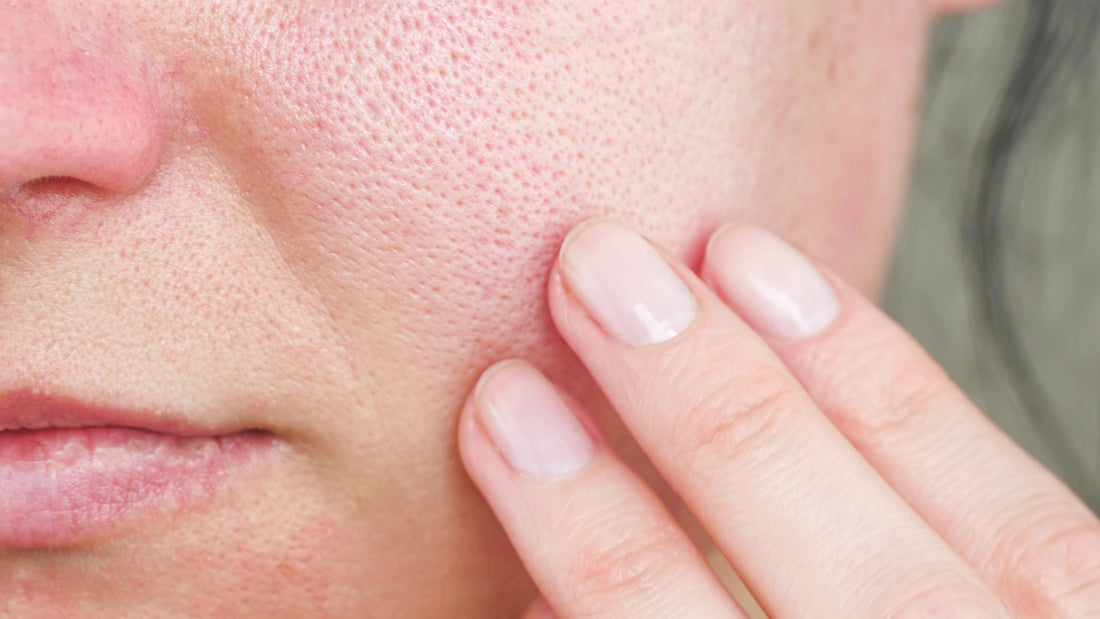
How To Calm Redness
We didn’t order splotches of redness, yet it occasionally arrives on our proverbial doorstep, nonetheless. The absolute cheek of it, pun intended. Truth be told, there are many, many reasons for a flurry of facial redness: perhaps you over-exfoliated, have had an allergic reaction, or overdone the sunshine sans SPF (tut tut!).
A stint of erythema (read: nerdie term for redness) could even signal an underlying skin condition. Rosacea is a common inflammatory skin disorder that affects a mahoosive 1 out of 10 hoomans in the UK. Typical symptoms? Facial flushing and redness; alongside other red-hued skin ailments like dilated capillaries and acne.
Those with atopic dermatitis, aka the most common type of eczema, cite red rashes as a symptom of the skin condition – as well as dryness and the urge to itch. It’s super common in mini hoomans but you can suffer from the disorder at any age.
Your redness could even signify that you have skin sensitisation: when your skin barrier becomes weakened by a trigger such as the weather, stress, or skincare products. But don’t worry – it's a skin condition that passes as quickly as it crops up when you’re equipped with the right skincare know-how.
While identifying the cause of your redness will help to prevent further flare-ups, it does little to soothe the present inflammation. But how do you care for red skin? I'm of the opinion that you’ll need an arsenal of protective, soothing, and replenishing ingredients to reduce facial redness and calm irritation.
More nerdiness: Skincare for Dehydrated Skin
Cleansing
Keep it gentle, keep it simple. Bombarding your red skin (maybe it’s a little sore, too?) with a treatment cleanser won’t alleviate the redness but only make it more inflamed. Instead, strip your skincare regimen back and reach for a gentle, nourishing cleanser that’ll remove any makeup, sebum, pollutant particles, and SPF without upsetting the delicate pH balance of your skin.
The Skingredients PreProbiotic Cleanse contains oligosaccharide, a skin-soothing prebiotic, and lactobacillus, a dairy-free probiotic which boosts the skin’s natural moisturising factor. Both balance and care for our microbiome, our skin’s ecosystem of bacteria, to bolster our skin barrier and defend against external aggressors. It also contains gluconolactone, a polyhydroxy acid, which gently exfoliates and acts like a humectant to draw moisture into skin.
Now, let’s show your body the same love. Our body skin can just as easily get red, sore, and inflamed yet we don’t give it as much attention as our faces. The Seavite Revitalising Shower Gel contains organic Ireland seaweed extracts which has anti-inflammatory properties that can heal and bring down redness in those with rosacea or acne.
Nerdie tip: don’t have the water temperature too high when you’re in the shower or bath. The humidity in the air will draw moisture from skin through a process called trans epidermal water loss. In essence, this means hot showers (however satisfying!) can exacerbate any redness and cause dehydration.
Soothe, Restore & Protect
A compromised skin barrier could be the underlying cause of your redness. Many triggers – like stress, over-exfoliation, the weather, airborne allergens – can weaken our lipid bilayer (aka skin barrier) to the point that it becomes permeable. In fact, hoomans with rosacea and acne often struggle with a weakened skin barrier function, too. In essence, a permeable skin barrier makes it much easier for irritants to penetrate skin and wreak havoc which causes inflammation and irritation (hello redness!). That’s why a soothing skin regimen that’s made up of barrier-repairing, hydrating, and anti-inflammatory ingredients is the key to calming redness.
Ceramides
Ceramides are naturally occurring lipids (aka fatty molecules) that make up our skin barrier. I like to think of ceramides as the skin’s “superglue” that holds dead skin cells in place for healthy skin barrier function. Put simply, ceramides are essential for retaining moisture and preventing irritants from entering and aggravating skin. Our ceramide supply depletes with age and unfortunately, those with acne, rosacea, and dry skin (to name a few) are said to have a ceramide deficiency. The good news? You can top-up your existing store of ceramides with skincare that’s rich in the fatty lipids.
A night cream like Skingredients Skin Good Fats is ideal as it protects skin from losing moisture overnight through a process called trans epidermal water loss. It contains a skin-native ceramide NP to bolster lipid supplies and fortify the skin barrier to prevent dehydration, as well as niacinamide, an antioxidant.
Niacinamide
Niacinamide, otherwise known as vitamin B3, is one of those hero ingredients that do plenty. For starters, niacinamide is a whizz kid ingredient that stimulates ceramide synthesis to grow a healthy lipid bilayer and protect skin from irritation and dehydration. Even more importantly (for the topic of this blog), niacinamide has anti-inflammatory properties that can reduce the appearance of redness – most notably if you suffer from acne. It’s also a powerful antioxidant that neutralises free radical activity to prevent skin damage – those pesky free radicals deplete collagen and elastin didn’t you know?
Niacinamide is present in Skin Good Fats, but it might be too rich for oilier skinned hoomans. In that case, meet the ASAP Skincare Super B Complex. It’s a lightweight serum with niacinamide to address redness, hyaluronic acid to boost hydration, and liquorice root extract for antioxidant protection. It can be used on irritated, congested, or sensitive skin to reduce the appearance of redness.
Centella Asiatica
Rumour has it that tigers rub against “tiger grass”, aka centella asiatica (or gotu kola), to heal wounds after battles. Our feline friends are onto something: it’s an incredibly calming ingredient with anti-inflammatory and antioxidant properties aplenty. A study published in the Indian Journal of Pharmaceutical Sciences in 2016, found that centella asiatica was able to improve skin redness and decrease transepidermal water loss – that equals hydrated, soothed skin.
Now, I’m a big believer in a cleanser, serum, and SPF being the cornerstone to every hoomans’ core skincare regimen – especially if your skin is particularly angry. However, a nourishing and healing face mask is a perfect “add on” when your skin needs a little extra care. The REN Evercalm Ultra Comforting Rescue Mask contains centella asiatica to reduce redness and inflammation, white mushroom extract to soothe irritation, and horse chestnut flower extract for antioxidant protection.

SPF
I highly doubt that I’ll ever publish a blog post without this very important addition: broad-spectrum SPF! While applying your daily SPF won’t ease any existing redness, it’ll protect your skin from UVB rays that can cause sunburn and the skin damage that comes from UVA rays. Notably, some super sensitive skin types can find chemical SPFs irritating to their skin which is why we would recommend using a physical SPF filter instead.
Physical SPF filters like titanium dioxide and zinc oxide sit on the surface of the skin and reflect UV rays away from the skin. They’re not absorbed by skin like a chemical SPF filter which means they’re non-irritating to sensitive or acne-prone skin. The Neostrata Sheer Physical Protection SPF50 contains titanium dioxide, a physical SPF filter, alongside vitamin E and green tea extract for antioxidant protection galore.
More nerdiness: Top Tips for Masks
Treatments for Redness
Naturally, there’s only so much our skincare can achieve. I would advise that you turn to more invasive skin treatments if your redness isn’t improving with the help of soothing, restorative, skin-protective ingredients. That’s only if you choose to address any redness, of course – skin in all its forms is beautiful.
There are many treatments available which are suited to different skin conditions. For example, an Intense Pulsed Light (IPL) treatment is fabulous for treating diffused redness, pigmentation, and post-inflammatory hyperpigmentation, aka the dark marks left behind once acne heals. IPL treatments use one wavelength of pulsating light to target the red colour in your skin. They work because the pigment cells in your skin absorbs the light energy which is converted into heat – it's the heat which fades the pigment.
Whereas a pulsed dye laser treatment works at specific wavelengths and addresses skin that has vascular lesions, red acne scars, background redness, spider veins and birthmarks. It has a dynamic cooling device protecting the upper epidermis, outermost layer of skin.
If you need a little extra guidance in the skincare department, book an online skin consultation with our team of qualified Nerds (aka skin consultants) and become a member of Skin Nerd Network. They have the nerdie know-how on redness, irritation, and sensitivity galore!
